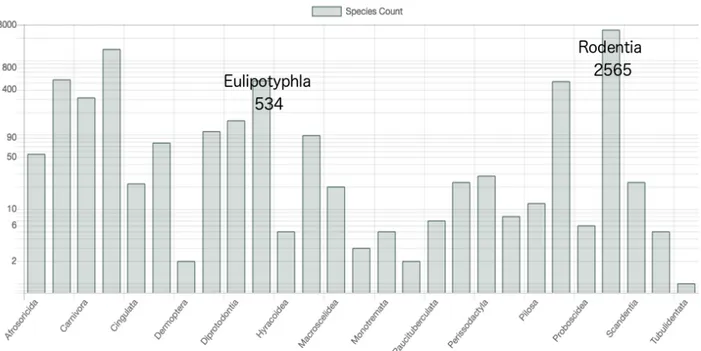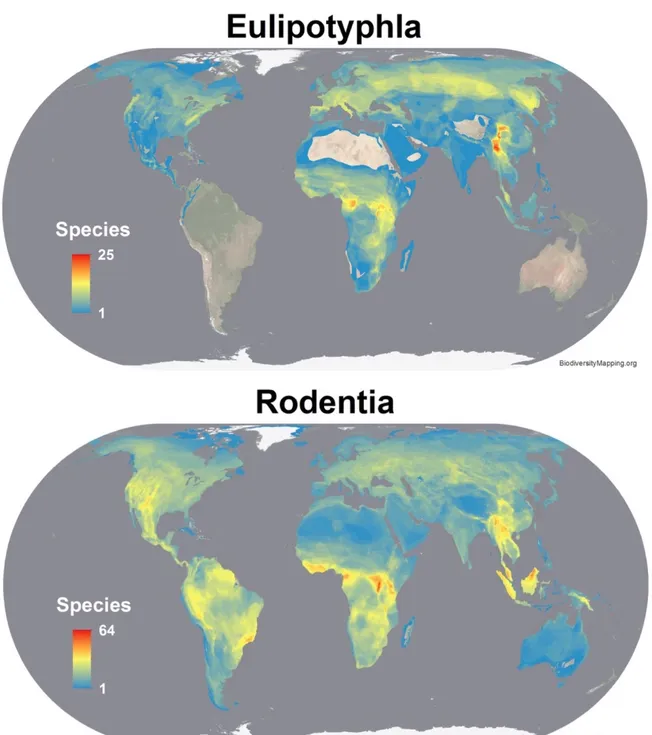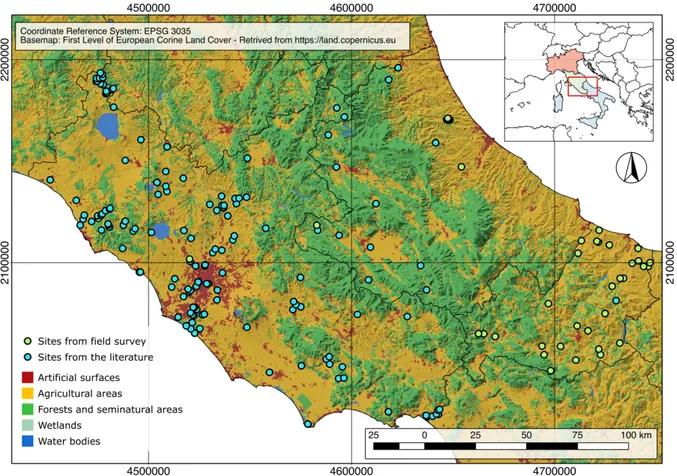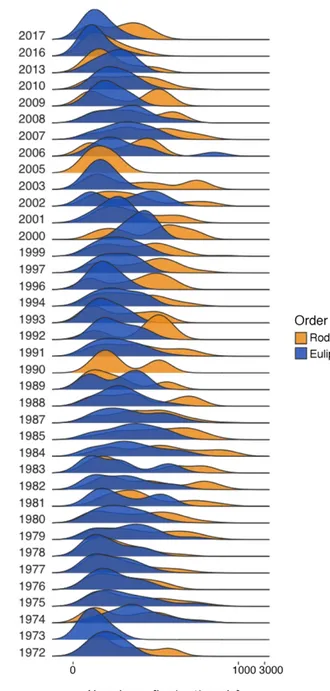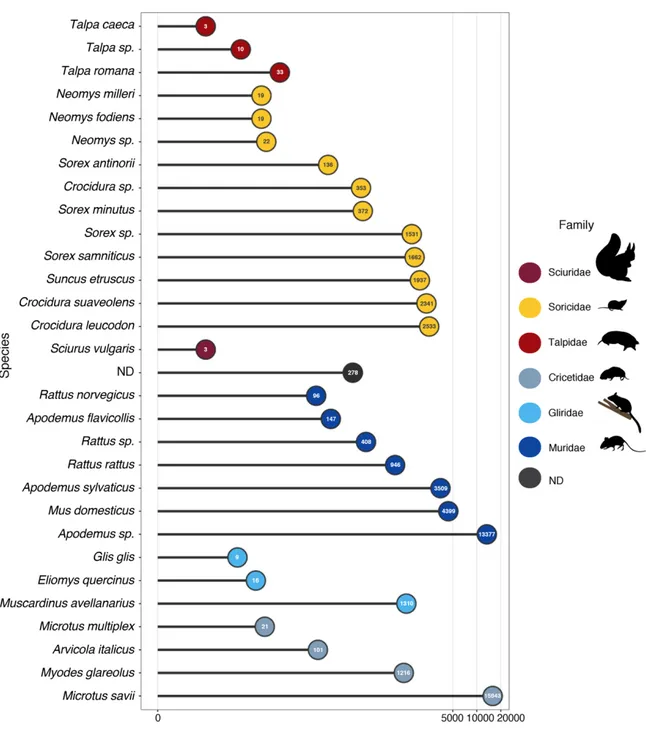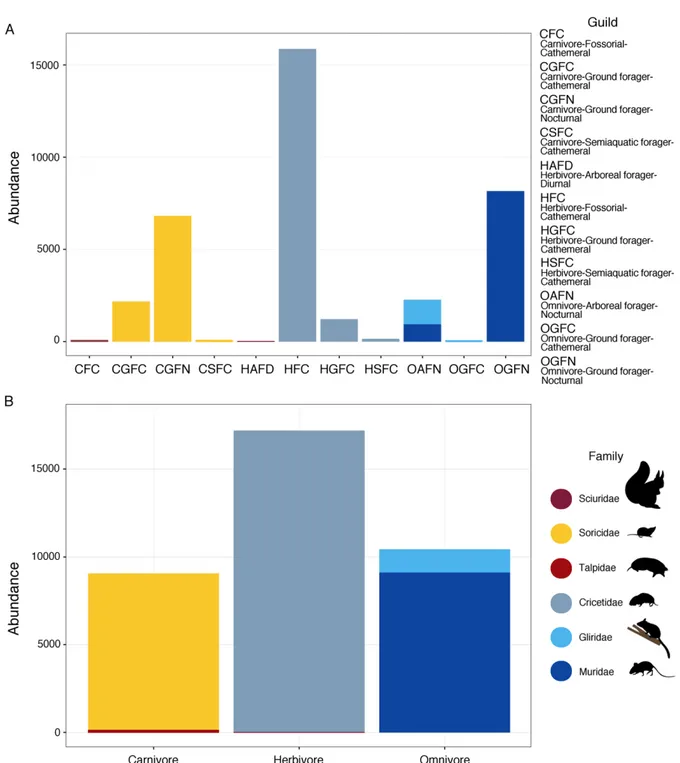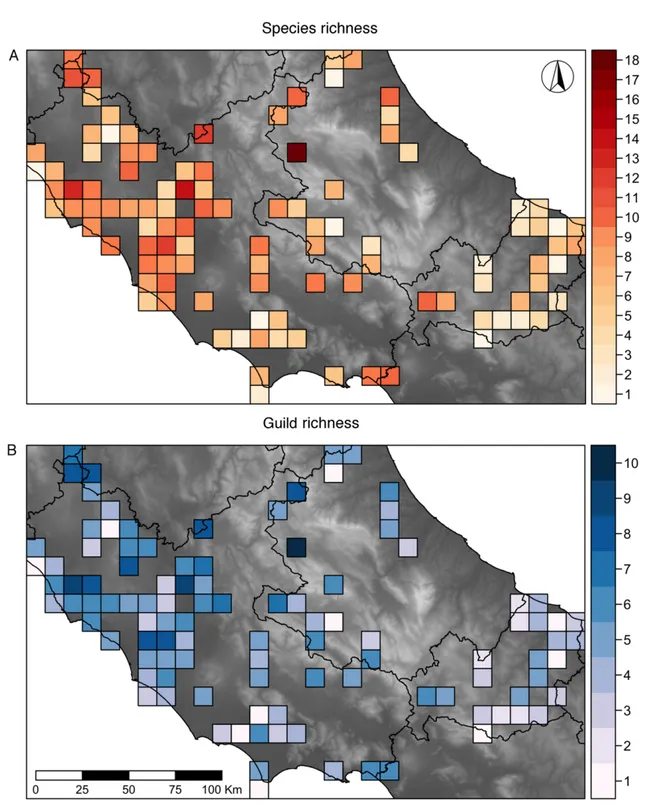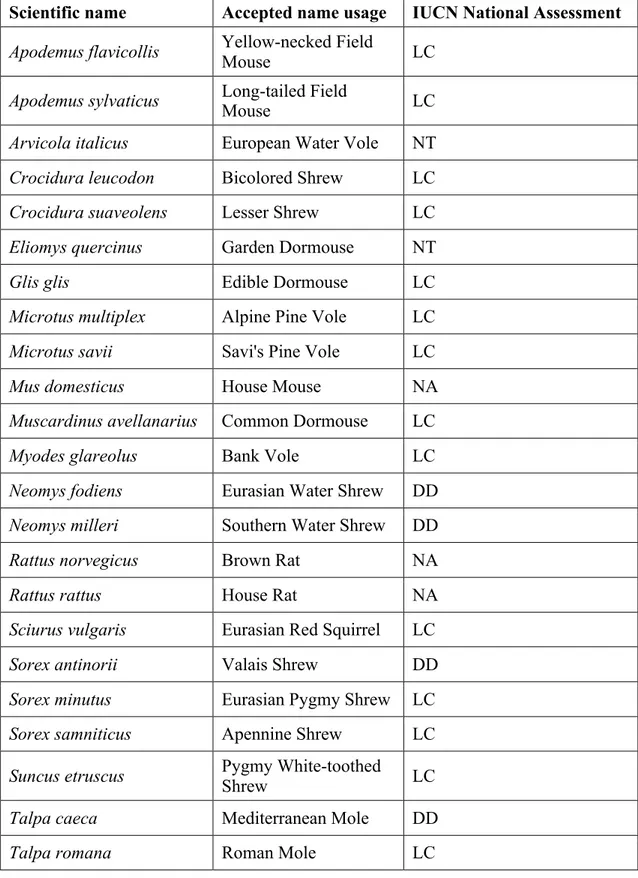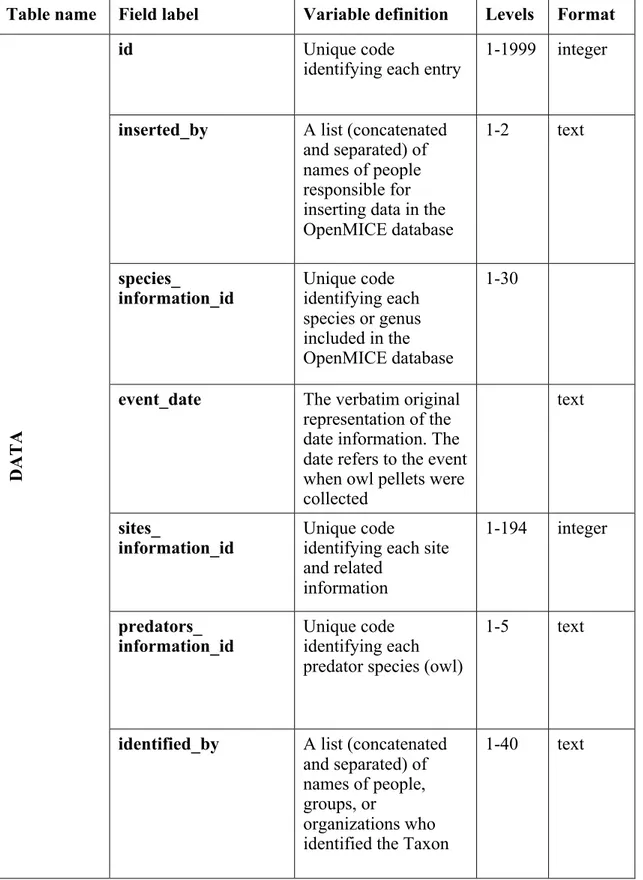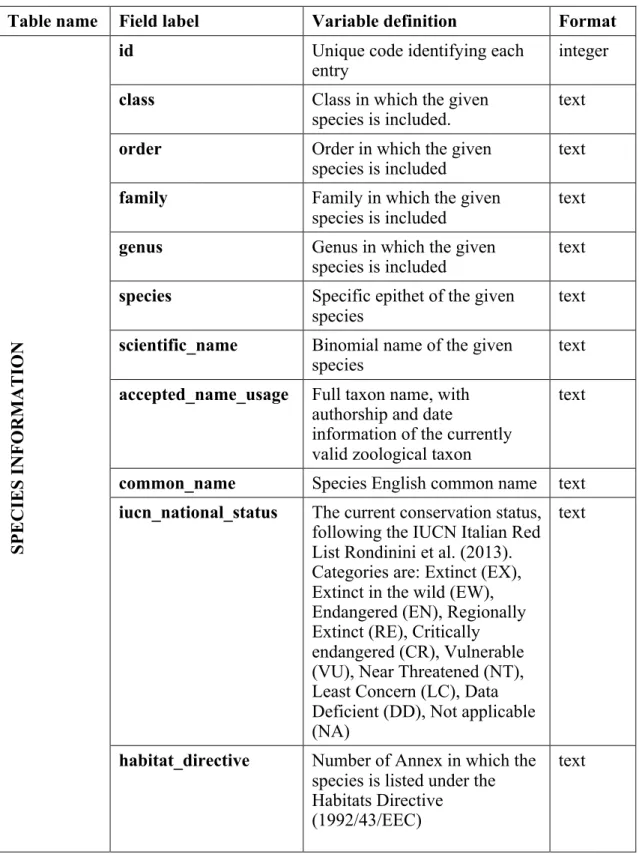1
SMALL MAMMALS IN A CHANGING LANDSCAPE: MONITORING COMMUNITIES FROM LOCAL TO LARGE SCALE
A dissertation presented by
Chiara Paniccia
Submitted to the Ph.D. School of the University of Molise, Department of Biosciences and Territory
Dottorato inBIOSCIENZEETERRITORIO(DOT1339138)XXXICICLO
Curriculum: Territoriale - Modellistica ambientale e costruzione di scenari spazio-temporali per la conservazione di specie e habitat
Settore scientifico disciplinare BIO/05 Zoologia
3
5
SMALL MAMMALS IN A CHANGING LANDSCAPE: MONITORING COMMUNITIES FROM LOCAL TO LARGE SCALE
Chiara Paniccia
Tutor:
Prof.ssa Anna Loy
Università del Molise
Dipartimento di Bioscienze e Territorio,
Contrada Fonte Lappone, 86090 Pesche, IS, Italia
Co-tutor:
Prof. Marco Marchetti Università del Molise
Dipartimento di Bioscienze e Territorio,
Contrada Fonte Lappone, 86090 Pesche, IS, Italia
Reviewers:
Prof. Giovanni Amori
CNR - Istituto di Ricerca sugli Ecosistemi Terrestri (IRET) Dipartimento di Biologia e Biotecnologie “C. Darwin”, Viale dell’Università 32, 00185 Roma, RM, Italia
Prof.ssa Francesca Cagnacci Fondazione Edmund Mach
Dipartimento di Biodiversità ed Ecologia Molecolare, Centro Ricerca e Innovazione,
7
SUMMARY 9
RIASSUNTO 11
FOREWORD 13
LIST OF CONFERENCES CONTRIBUTIONS ASSOCIATED WITH THE PH.D.THESIS 15
LIST OF PAPERS 15
KEY RESEARCH CONTRIBUTIONS 15
POSTER COMUNICATION 15
ORAL COMUNICATION 17
CHAPTER I 19
INTRODUCTION AND OBJECTIVES 19
1INTRODUCTION 21
1.1SMALL MAMMALS IN ECOSYSTEMS 21
1.2SMALL MAMMALS AS BIOINDICATORS 25
1.3SMALL MAMMAL DATABASE AND DATA MANAGEMENT 26
1.4OBJECTIVES OF THE RESEARCH PROJECT 27
REFERENCES 29
CHAPTER II 35
SMALL MAMMAL DATABASE 35
2.1OPENMICE: AN OPEN SPATIAL AND TEMPORAL DATA SET OF SMALL MAMMALS IN SOUTH-CENTRAL
ITALY BASED ON OWL PELLET DATA. 37
2.1.2METADATA 40
CHAPTER III 85
SMALL MAMMALS IN APENNINE DECIDUOUS MONTANE FOREST: STUDYING
ECOLOGICAL NICHES FOR A SUSTAINABLE FOREST MANAGEMENT 85
3.1EFFECT OF IMPERFECT DETECTION ON THE ESTIMATION OF NICHE OVERLAP BETWEEN TWO FOREST
DORMICE. 87
3.1.2SUPPLEMENTARY MATERIAL 97
CHAPTER IV 109
DISTRIBUTION OF SMALL MAMMAL COMMUNITIES ACROSS MEDITERRANEAN
LANDSCAPES 109
4.1DISTRIBUTION OF SMALL MAMMAL COMMUNITIES ACROSS MEDITERRANEAN LANDSCAPES 110
8
CHAPTER V 147
CONCLUSION AND PERSPECTIVES 147
5.1CONCLUSION 149
5.2.LIMITATIONS AND CAVEATS OF RESEARCH 150
5.3FUTURE CHALLENGES 152
REFERENCES 154
9
Summary
Small mammals are an extremely diverse non-taxonomic group, which provide many ecosystem services and play important ecological roles. Rodents and insectivores are generally characterized by small body size, high litter size, high prolificity, arboreal or fossorial habits. Some of them possess a specialized diet, a trait linked to climate and land-use changes vulnerability. Despite these characteristics make small mammal communities’ make good candidates as ecological indicators, few studies have explored this aspect, i.e. environmental factors affecting species composition and abundance, especially in Mediterranean ecosystems.
My Ph.D. project was aimed at collecting and archiving a large data set on small mammal occurrences in south-central Italy, and investigating how they are affected by human activities at different spatial scales, from local (i.e. stand scale - forest management) to broad scale (i.e. landscape scale-land-cover/land-use change), and thus how this diverse group could be used as ecological indicator of human driven environmental changes.
The specific aims of my Ph.D. project were:
i) Developing of an open-access georeferenced database of small mammal occurrences, abundance, and functional traits based on owl-pellet data;
ii) Analyzing the influence of micro-habitat characteristics and sustainable forest management practices on arboreal rodents to evaluate how these species could act as bio-indicator of alternative forest management practices. This project has a focus on a Molise region’ forested areas;
iii) Investigating the relationships between small mammal communities and landscape heterogeneity at large geographic scale in three south-central Italian regions (Lazio, Abruzzo, and Molise).
During my research project, I implemented and designed the first standardized and accessible georeferenced database of small mammal communities based on owl pellets covering the years 1972 to 2017, including nearly 2000 records for 190 sites of south-central Italy. The relational OpenMICE database has made more widely available a remarkable amount of small mammal data to the scientific community that usually are accessible only to a restricted audience. OpenMICE will likely help in gaining a better understanding of ecological
10
processes occurring in human-impacted landscapes. It also filled part of the knowledge gap on small mammals’ occurrence in the study area to guide future sampling and conservation efforts. The results of my project may serve to prioritize conservation areas for small mammals and to design adaptive management of EU habitats and species.
At a fine-scale, I investigated niche similarity of two forest dormice (Muscardinus
avellanarius and Glis glis) in a mixed deciduous forest of Molise, and how accounting for
imperfect detection can improve the statistical significance and interpretability of niche overlap estimates based on occurrence data. I combined two different modelling approaches: ‘Occupancy models’ and ‘General Linear Mixed Models’. Arboreal rodents were surveyed in a forest of south-central Italy, and relative abundances were compared to a set of forest structural factors and habitat requirements. The key output was the definition of species-specific habitat relationships that refined information on arboreal rodent species and their distribution, and their response to forest structure and practices. In such a perspective, our findings offered a methodological framework to assess the degree of forests naturalness and to explore effects of alternative forest management systems, highlighting the importance of sustainable use of forest products in maintaining crucial biodiversity resources. In a forest management context, our quantification of niche overlap provided useful information to assess the effects of different management practices on the occurrence of these arboreal species.
At a broad-scale, the research project was focused on the effect of landscape composition and structure (i.e. measured by landscape metrics) on small mammal communities. This study will provide insights on the small mammal complex responses to habitat change from the community-level of view and represents a baseline to future predictions of possible trends under future scenarios. Finally, results may potentially provide a powerful method in support of management and planning options for land-use change mitigation and adaptation.
Key words: Landscape changes; Central Apennines; Community Ecology; Biodiversity indices; Bioindicators
11
Riassunto
I piccoli mammiferi sono un gruppo non tassonomico estremamente diversificato che fornisce numerosi servizi ecosistemici e svolge una serie di importanti ruoli ecologici. Roditori ed insettivori sono generalmente caratterizzati da piccole dimensioni corporee, abitudini fossorie o arboricole e dalla dieta spesso altamente specializzata. Queste caratteristiche rendono alcune specie appartenenti a questo gruppo sensibili ai cambiamenti climatici e alle trasformazioni ambientali, quali le alterazioni di copertura ed uso di suolo. Malgrado i piccoli mammiferi vengano considerati dei buoni indicatori ecologici, ad oggi, sono pochi gli studi che hanno esplorato questo loro ruolo applicativo negli ecosistemi mediterranei.
Il mio studio si è focalizzato sulla raccolta di un ampio set di dati di piccoli mammiferi nelle regioni dell’Italia centro-meridionale, sulla comprensione di come specie e comunità di piccoli mammiferi vengano influenzate dalle attività umane a diverse scale spaziali, partendo dalla scala locale (gestione forestale) a quella più ampia (land-use /land-cover) ed infine, come, queste specie possano essere utilizzate per monitorare cause e processi dei cambiamenti ambientali indotti dall’uomo.
In dettaglio il mio progetto ha seguito i seguenti obiettivi:
i) Raccolta e archiviazione di presenze, abbondanze e tratti ecologico-funzionali di piccoli mammiferi tramite dati provenienti da borre di rapaci notturni;
ii) Analisi dell'influenza delle caratteristiche di microhabitat e delle pratiche di gestione forestale su due specie di roditori arboricoli nelle foreste del Bacino della Vandra (centro Italia);
iii) Studio delle relazioni tra la diversità dei piccoli mammiferi ed eterogeneità di paesaggio su larga scala geografica. In particolare, è stata indagata l’influenza della configurazione spaziale del paesaggio su tali comunità.
Nello specifico, il mio progetto di dottorato ha permesso di archiviare un ampio data set di presenze, abbondanze e tratti ecologico-funzionali per 23 specie di piccoli mammiferi coprendo un range temporale di 45 anni (1972 al 2017). Sono stati georeferenziati circa 50.000 individui in 190 siti dell'Italia centro-meridionale (Lazio, Abruzzo, Molise). La creazione del database relazionale openMICE ha colmato parte del gap conoscitivo per l’area mediterranea: ha permesso di sviluppare un database storico di informazioni potenzialmente
12
utile alla comunità scientifica; ha reso fruibili ad un ampio pubblico numerosi dati di solito accessibili solo a specialisti; ha reso disponibili dati ecologici utili per future ricerche interessate a quantificare la perdita di biodiversità.
A scala fine il mio studio ha sottolineato come l’uso dei modelli di “occupancy” possa migliorare la significatività statistica e l'interpretabilità della nicchia ecologica e del “niche
overlap” (sovrapposizione della nicchia ecologica). Tale approccio ha permesso di
discriminare strategie ecologiche alternative tra le due specie studiate. Il ghiro ha esibito una relazione significativa con le foreste ad alto fusto, mentre il moscardino ha mostrato preferenze per una varietà di tipi forestali. Queste differenze potrebbero essere dovute principalmente alle diverse abitudini alimentari e al grado di specializzazione delle due specie. In un contesto di gestione forestale, un'accurata quantificazione della sovrapposizione di nicchia permette di progettare pratiche mirate ad un uso sostenibile delle foreste che permetta di mantenere un’elevata diversità animale al loro interno.
Poiché alcuni taxa sono più sensibili al cambiamento dell'habitat rispetto ad altri, un approccio multi-tassonomico potrebbe essere utile per valutare la risposta della biodiversità e per pianificare strategie di conservazione in paesaggi modificati dall'uomo. Il mio studio ha consentito di identificare e quantificare, come e se le comunità di piccoli mammiferi sono influenzate dalla composizione del paesaggio o dalla sua configurazione e se queste caratteristiche possono essere collegate al declino della ricchezza o dell’abbondanza specifica dei piccoli mammiferi stessi.
I risultati del mio progetto, costituiscono una base di partenza per focalizzare aree prioritarie di conservazione per i piccoli mammiferi, guidare i futuri sforzi di campionamento e conservazione e sono un valido strumento per la gestione adattativa di specie e habitat nell’area Mediterranea.
Parole chiave: Modificazioni del paesaggio; Ecologia di comunità; Indici di diversità biologica; Italia centro meridionale; Bioindicatori
13
Foreword
This thesis reports advances and findings of 36-months Ph.D. research project at the Department of Biosciences and Territory – DiBT, University of Molise, Italy.
The thesis has been supervised by Professor Anna Loy, but also Professor Marco Marchetti, University of Molise, and Professor Duccio Rocchini of Center Agriculture Food Environment, University of Trento, has functioned as an external supervisor though not officially affiliated with the project.
The research activities were based at the Environmetrics Lab and Zoology Lab at the University of Molise, though the research project involved national and international collaborations which allowed me to visit and work in various institutions abroad. Specifically, I spent six months in the laboratory of Applied Ecology, at the Fondazione Edmund Mach (Italy) and six months in the Remote Sensing and Biodiversity Research, Department of Remote Sensing at the University of Wurzburg (Germany).
The thesis consists of five chapters. First, a synopsis giving the background, overview, objectives, main findings of the thesis, and future perspectives. The central chapters consist of three research manuscript that are published, or in preparation for publication in ISI journals.
The common framework of my research project and articles is the use of different model techniques to quantify if small mammal communities have changed throughout time and space. The last chapter includes discussion, advances, and results for my research. While being a Ph.D. student, I have also acted as co-supervisor on one master thesis, as well as assistant to teaching the course ‘Zoology’ (SSD-BIO05) and ‘Ecology’ (SSD-BIO07). Hence, my works have been presented at two International conferences on Rodent Biology and Management and at various Italian conferences.
More specifically:
Chapter I provides the background of the project, with a particular reference to Conservation Biology, Community Ecology, Biology and Taxonomy of Rodentia and Euliphlotypla. The necessity for studying small mammal communities is presented, as well as the opportunity that different scale approaches provide toward the implementation of cooperative conservation strategies for small mammals. The gap in scientific knowledge that justified the rationale of this research and its objectives were described in detail.
14
Chapter II provides the results of a two-year project run in collaboration with experts of small mammal ecology and database management from various research institution (Fondazione Edmund Mach, and University of Trento).
The outcomes of the work were published in ‘Ecology’ (Paniccia C, Di Febbraro M, Delucchi L, et al (2018) OpenMICE: an open spatial and temporal data set of small mammals in south-central Italy based on owl pellet data. Ecology. doi: 10.1002/ecy.2506).
Chapter III includes the results of testing the use of occupancy and niche overlap to study arboreal rodent species at a local scale. The outcomes of the work were published in ‘iForest - Biogeosciences and Forestry’ (Paniccia C, Di Febbraro M, Frate L, et al (2018) Effect of imperfect detection on the estimation of niche overlap between two forest dormice. IForest 11:482–490 . doi: 10.3832/ifor2738-011).
Chapter IV provides the outcomes of the spatial-temporal modeling and community ecology analyses of species’ biological traits (such as body mass, activity pattern or reproductive parameters) to determine a community’ resilience, which results are still ongoing.
Chapter V provides a general discussion on the contribution of the Ph.D. project to the improvement of knowledge and methodologies for monitoring and studying small mammal communities through time, space and spatial scales. The relevance for wildlife management and conservation is discussed as well. Finally, future research directions are discussed.
15
List of conferences contributions associated with the Ph.D. Thesis
The research arguments included in this Ph.D. thesis have been presented as contributions in various international conferences in the form of poster or oral presentations.
A selection of the most relevant contributions is provided below.
List of papers
Paniccia C, Di Febbraro M, Frate L, et al (2018) Effect of imperfect detection on the estimation of niche overlap between two forest dormice. IForest 11:482–490 . doi: 10.3832/ifor2738-011
Paniccia C, Di Febbraro M, Delucchi L, et al (2018) OpenMICE: an open spatial and temporal data set of small mammals in south-central Italy based on owl pellet data. Ecology. doi: 10.1002/ecy.2506
Key research contributions Poster comunication
16th International Conference of Rodent Biology and Management & 16th Rodens et Spatium, Potsdam, Germany September 3-7, 2018
Paniccia C., Rocchini D., Frate L., Di Febbraro M., Mumme S, Loy A (2018). Small mammal richness and diversity in the changing landscape of central Italy. In Proceedings of the 6th International Conference of Rodent Biology and Management & 16th Rodens et Spatium, 3-7 September 2018, Potsdam, Germany
XI ATIT Italian Mammal Society Congress, Firenze (FI), Italy June 19-20, 2018
Paniccia C., Di Febbraro, Delucchi L., Oliveto R., Marchetti M., Loy A (2018). An Accessible Georeferenced Database of Small Mammals. Hystrix, Italian Journal of Mammology, 29(suppl.): 80 p.
XI Congresso Nazionale SISEF, Roma, Italia 10-13 Ottobre, 2017
Paniccia C., Di Febbraro M., Frate L., Sallustio L., Santopuoli G., Altea T., Posillico M., Marchetti M., Loy A. (2017). Can imperfect detection misrepresent niche overlap? A case study on two dormice in an Apennine deciduous montane forest. In: Proceedings of the XI SISEF National Congress “La Foresta che Cambia: Ricerca, qualità della vita e opportunità in un paese che cambia” (Fares S, Alivernini A, Ferrara C, Marchi M, Sallustio L, Chianucci F, Bucci G eds). Rome (Italy) 10-13 Oct 2017. Abstract-book, Paper #c11.22.6. [online] URL: http://www.sisef.it/sisef/xi-congresso/
16
International conference “Quo vaditis agriculture, forestry and society under Global Change?” Velké Karlovice, Czech Republic October 2-4, 2017
Vizzarri M., Antonucci S., Calderaro C., Cocozza C., Conte E., De Toni A., Di Febbraro M., Di Martino P., Evangelista A., Frate L., Fravolini G., Garfì V., Lasserre B., Lombardi F., Ottaviano M., Palombo C., Paniccia C., Perone A., Sallustio L., Santopuoli G., Tognetti R., Tonti D., Marchetti M. From cell to landscape: a multi-scale framework to study climate change effects on forest ecosystems - International conference “Quo vaditis agriculture, forestry and society under Global Change?” 2 th - 4th October 2017, Velké Karlovice (Czech Republic)
III Convegno Nazionale sui Piccoli Mammiferi, Colle Val d’Elsa (SI), Italia 8-9 Novembre, 2017
Pascarelli M., Paniccia C., Scaravelli D., Loy A. (2017). Structural diversity of small mammal communities in Molise, Italy: first evidence from a broad-scale sampling of owl pellets. In: Atti III Convegno Nazionale sui Piccoli Mammiferi “Piccoli mammiferi tra gestione e conservazione”, 8-9 Novembre 2017, Colle Val d’Elsa (SI), Italia
III Convegno Nazionale sui Piccoli Mammiferi, Colle Val d’Elsa (SI), Italia 8-9 Novembre, 2017
Monti I.E., Paniccia C., Mori E., Raimondi F., Augugliaro C. (2017). Small Mammals of Mongolia. Reports from the Scientific Expedition. In: Atti III Convegno Nazionale sui Piccoli Mammiferi “Piccoli mammiferi tra gestione e conservazione”, 8-9 Novembre 2017, Colle Val d’Elsa (SI), Italia Giornate della Ricerca scientifica Dipartimento di Bioscienze e Territorio, Pesche (IS), Italia 1-2 Marzo, 2017
Paniccia C., Di Febbraro M., L. Frate L., Scaravelli D., Pascarelli M., Marchetti M., Loy A. 2017. Where did small mammal communities go? “MICE” database as a monitoring tool for the effects of climate and land-cover changes in central Italy. In: Atti delle giornate della ricerca scientifica Dipartimento di Bioscienze e Territorio, 1-2 Marzo 2017, Pesche (IS), Italia
15th Rodens et Spatium, International Conference on Rodent Biology, Olomouc, Czech Republic July 25-29, 2016
Paniccia C., Di Febbraro M., Altea T., Frate L., Posillico M., Sallustio L., Santopuoli G., Marchetti M., Loy A. 2016. Structural niche overlap of two forest dormouse species: effects of imperfect detection on accuracy of estimates. In Proceedings of the 15th Rodens et Spatium, 148 p. ISBN 978-80-244-4984-5.
X ATIT Italian Mammal Society Congress, Acquapendente (VT), Italy April 20-25, 2016 Paniccia C., Di Febbraro M., Altea T., Posillico M., Sallustio L., Marchetti M., Loy A. 2016. Investigating microhabitat structure and spatial niche overlap of two sympatric dormouse species. A case-study in a Central Apennine forest. Hystrix, Italian Journal of Mammology, 27(suppl.): 128p.
17
Oral comunication
Conferenza dei Dottorati di ricerca “Sostenibilità e cambiamento”. Università degli Studi del Molise, (14/12/2016)
Paniccia C. Le comunità microteriologiche in un paesaggio che cambia: problematiche e scenari futuri. Conferenza dei Dottorati di ricerca “Sostenibilità e cambiamento”. Università degli Studi del Molise, Via De Sanctis, 86100, Campobasso, Italia
Giornate della Ricerca Scientifica, Dipartimento di Bioscienze e Territorio (1-2 Marzo 2016) Paniccia C., Di Febbraro M., Altea T., Frate L., Bucci R., Posillico M., Sallustio L., Santopuoli G., Marchetti M., Loy A. Investigating the influence of forest management and microhabitat structure on the relative abundance of small-rodents in Central Apennines. An occupancy modelling approach. Proceedings of the days of scientific research Department of Biosciences and Territory, 1-2 March 2016, Pesche (IS), Italy
19
CHAPTER I
21
1 Introduction
Small mammals are an extremely diverse, non-taxonomic group, that provide many ecosystem services and play a number of important ecological roles (Zachos 2018a, b). Most research on small mammal decline has focused on limited spatial and temporal scales, especially in the Mediterranean region (Szpunar et al. 2008; Rugiero et al. 2012; Moreno and Rouco 2013). To better understand the relationships between diversity loss, community changes and its causes, a broader spatial-temporal approach is needed.
My Ph.D. project aimed at collecting and archiving a large data set on small mammal occurrences in south-central Italy, and investigating how they are affected by human activities at different spatial scales, from local (i.e. stand scale - forest management) to broad scale (i.e. landscape scale-land-cover/land-use change), and how ecological organizations of this diverse group could be used as an ecological indicator.
1.1 Small mammals in ecosystems
Rodentia and Eulipotyphla are two of the most important orders of mammals, both in terms of number of species and in geographical distributions (Zachos 2018a, b), and are typically addressed as small mammals. Small mammals provide important ecosystem services and functions such as seeds dispersal (Xiao et al. 2005, 2006), spore dispersal (Martin 2003), pollination (Melidonis and Peter 2015), nutrient cycling (Hayward and Phillipson 1979; Fischer et al. 2018), etc. They include species that have adapted to human beings and followed them as they spread across the globe.
22
Figure 1. Histogram showing the global richness of Rodentia and Eulipotyphla in the Mammalia
species diversity. Credit: Mammal Diversity Database (https://mammaldiversity.org/)
The order Rodentia contains about 40% of all known species of mammals, making it by far the most speciose order of mammals (Wilson, D.E., Lacher, T.E., Mittermeier 2016; Figure 1). They are the most diversified mammalian order, live in a variety of terrestrial habitats, including human-made environments, and can be found in all continents except Antarctica, throughout a wide variety of habitats from deserts to tropical rainforests and human modified landscapes such as urban areas (Wilson, D.E., Lacher, T.E., Mittermeier 2016).
This remarkable diversification and diffusion have been made possible by a vast array of morphological behavioral adaptations that allowed them not only to thrive in the world ecosystems but also to play a major role in their functioning.
Currently, 2566 species and 513 genus of Rodentia are described (ASM 2018).
The order Eulipotyphla includes 534 species and 56 genus and five families: Erinaceidae (hedgehogs and moonrats), Talpidae (moles), Solenodontidae (solenodons), Soricidae (shrews) and the extinct family Nesophontidae (Douady et al. 2002; Hutterer 2005; ASM 2018).
All the Eulipotyphla are small, ground-dwelling or subterranean mammals, and they mainly feed on invertebrates (Hutterer 2005; Zachos 2018a).
23
Small mammal diversity is differently distributed at global scale, especially in tropical areas (Jenkins et al. 2013; Pimm et al. 2014; Figure 2). In a global context, Italian small mammal fauna are unique and rich in endemisms (i.e. Sorex samniticus, Talpa romana, Sciurus
meridionalis, Dryomys aspromontis) (Wauters et al. 2017; Amori and Castiglia 2018;
Bisconti et al. 2018).
Figure 2. World maps of diversity include the total species richness for Eulipotyphla and Rodentia
24
As some of the most abundant and widely distributed animals on the earth, it is not surprising that small mammals play key roles in ecosystems.
i) Their main ecological functions are:
ii) Vegetables consumers (rodents) or invertebrates (insectivorous);
iii) Relatively abundant and widespread prey for many vertebrates (e.g. meso-carnivores and birds);
iv) Active soil stirrings, aerators and fertilizers;
v) Act as prominent seeds, fungi, and spore disperser;
vi) As damaging for forest ecosystem and agricultural cultivation, and foodstuff.
These diverse and important roles make small mammals capable of influencing ecosystems energy fluxes and are often an important component of well-structured ecological networks (Dickman 1999; Pearce and Venier 2005; Hurst et al. 2014).
Among species groups that coexist in different landscapes, small mammals are crucial due to their contribution to well-structured food webs (Ostfeld and Keesing 2000; Salamolard et al. 2000; Butet and Leroux 2001), owing to their consumption and dispersal of plant material, seeds, and in turn, the growth and survivorship of those plants (Kollmann and Bassin 2001; Kollmann and Buschor 2003; Fischer et al. 2011). These relationships are observed in a several ways, but primarily through two processes: seed consumption and seed caching (Wilson, D.E., Lacher, T.E., Mittermeier 2016). Rodents, in particular, have also been identified as important dispersers of mycorrhizal fungi (Maser et al. 1978; Janos et al. 1995; Schickmann et al. 2012), many of which play critical roles in the ecosystems in which they exist. Several types of hypogenous fungi, such as truffles, rarely almost entirely on the dispersal of their spores by small herbivorous mammals like rodents (Wilson, D.E., Lacher, T.E., Mittermeier 2016). This process of distributing fungal spores and facilitating fungal growth in ecosystems play a crucial role in forest succession and the reestablishment of forest following significant disturbance events such as fires (McMullan-Fisher et al. 2011).
Eulipotyphla have also been identified as important consumers and controllers of invertebrates (Saarikko 1989; Gliwicz and Taylor 2002; Amori et al. 2008).
Human activities, especially the conversion and degradation of habitats, are causing global biodiversity declines. Europe has a long-standing history of human-induced landscape modification starting in the Holocene, 10,000 years ago (Antrpo 2004). This dramatic process
25
is certainly among the most powerful drivers of changes in wildlife distribution in the Anthropocene (Steffen et al. 2011). However, how local ecological assemblages are responding to such changes is less clear, and given their importance for many ecosystem functions and services, these processes should deserve more attention than that paied up to now by the scientific community.
Rodents and insectivores are generally characterized by large litter size, frequent litters, relatively short generation periods (Paniccia et al. 2018a; Zachos 2018a, b). Among them, rodents are typed by more ecological generalism compared to insectivores.
These characteristics, together with fossorial or arboreal habits, make rodents highly adaptable and able to cope with environmental changes, including climate (Pacifici et al. 2017). They have sufficient mobility to respond to alterations at different landscape scales (Michel et al. 2007; Rowe et al. 2015) or habitats (Pardini et al. 2005; Rodríguez and Peris 2007; Arnan et al. 2014; Marques et al. 2015). As small mammals rapidly respond to environmental change, due to their short life cycles and restricted spatial areas, such species can serve as model organisms for a better understanding of ecosystem and landscape processes (Barrett and Peles 1999) at different levels of complexity (i.e. community, population, species, etc.).
Small mammals are recognized as pests for the negative impacts they can have on certain aspects of ecosystems, also on human health and livelihood. Numerous studies have been shown negative impacts of small mammal populations on extensive annual crop, forests, and plantations, and their role in the spread of diseases (Borrecco 1976; Gratz 1988; Dickman 1999; Jacob and Tkadlec 2010).
Lastly, it should be remembered that Rodentia and Eulipotyphla are often seen as pests, yet they are actually among the most important animals on the planet. Humans, indeed, have long exploited small mammals for several purposes, including food, articles of clothing, as pets, or models organisms for laboratory studies and medical testing (Amori et al. 2008; Wilson, D.E., Lacher, T.E., Mittermeier 2016).
1.2 Small mammals as bioindicators
Small mammals are considered biological indicators of environmental risk, since they are used to monitoring metal pollutants (Ma 1989; Ieradi et al. 1998; González et al. 2008;
26
McLean et al. 2009; Scott et al. 2012) present in ecosystems, as well as radionuclides (Cristaldi et al. 1985, 1991, 2013; Baker et al. 1996).
Numerous research have been using small mammals species to understand the impacts of climate changes on biodiversity (Szpunar et al. 2008; Rugiero et al. 2012; Royer et al. 2016; Villar and Naya 2018); or to evaluate fragmentation and/or loss habitats in a variety of ecosystems such as forests (Capizzi et al. 2003; Mortelliti et al. 2009, 2014; Bovendorp et al. 2018), deserts (Ernest et al. 2009; Bowman et al. 2017; Guevara and Ball 2018), and agro-ecosystems (Bond et al. 2004; Hurst et al. 2014; Fischer et al. 2018; Berl et al. 2018).
1.3 Small mammal database and data management
To study and understand small mammal changes and their response to human pressure we need a great amount of data to monitoring communities and species through time and space. Despite the rapidly increasing number of data sets across many taxonomic groups, data on small mammals are still scarce and underrepresented if compared to their global species richness (Wikelski et al. 2007). Only few recent studies have focused on big-data of small mammals, that can be a useful tool to study changes from a macroecological point of view (Escribano et al. 2016; Bovendorp et al. 2017; Mendonça et al. 2018). This is likely due to the elusiveness of small mammals as well as to problematics regarding taxonomic identification. Small mammals mainly include morphologically similar, small-sized and furtive species, making direct observation and identification logistically complicated. Small mammal’ morphological and physiological characteristics as well as occurrences and abundances data may be collected in a precise way using live-traps (Flowerdew et al. 2004; Chiron et al. 2018) or through indirect samplings including droppings (Pocock and Jennings 2006), tracking-plates (Glennon et al. 2002; Hacker et al. 2016), hair-traps (Chiron et al. 2018), nest-boxes (Bright et al. 1994), and remains from owl pellets (Bonvicino and Bezerra 2003). Among these methods, owl pellet remains can provide data on a wide array of species living in a restricted area (Heisler et al. 2016), while the others target only one or few species (Mortelliti and Boitani 2007; Bertolino et al. 2009). Although small mammal sampling based on owl pellets presents some degrees of spatial inaccuracy (i.e. equivalent to the hunting range of the predator), it represents a cost-effective and efficient method to sample small mammal communities across broad spatial and temporal scales (Torre et al. 2004; Heisler et al. 2016). In addition, by including data on relative abundances, this method provides quantitative data
27
to investigate ecological processes at broad scales (Kattge et al. 2011; Sundstrom et al. 2012; Hurst et al. 2014), as well as the response of mammal communities to local or global changes (Lovegrove 2003; Blois et al. 2010; Santini et al. 2016; Pacifici et al. 2017).
1.4 Objectives of the research project
In this context, the specific aims of my Ph.D. project were:
1) Collecting and storing in an open-access georeferenced database, all available and newly gathered owl-pellet data for south-central Italy;
2) Analyzing the influence of micro-habitat and sustainable forest management practices on arboreal rodent species and evaluating of how species could act as bio-indicator of alternative forest management practices. This project has a focus on a Molise region’ forested areas;
3) Investigating the relationships between small mammal diversity and landscape heterogeneity on a large geographic scale. Specifically, studying the consequences of landscape spatial configuration and its changes on small mammal communities. The study covers three Italian regions (Lazio, Abruzzo, and Molise).
29
References
Amori G, Castiglia R (2018) Mammal endemism In Italy: A review. Biogeogr – J Integr Biogeogr 33: . doi: 10.21426/B633035335
Amori G, Contoli L, Nappi A (2008) Mammalia II: Erinaceomorpha, Soricomorpha, Lagomorpha, Rodentia. Vol. XLIV. Fauna d’Italia Ed Calderini Sole-24 Ore, Milano Antrpo M (2004) Landscape change and the urbanization process in Europe. Landsc Urban
Plan 67:9–26 . doi: 10.1016/S0169-2046(03)00026-4
Arnan X, Comas L, Gracia M, Retana J (2014) Composition and habitat use of small mammals in old-growth mountain forests. J Nat Hist 48:481–494 . doi: 10.1080/00222933.2013.800611
ASM (2018) Mammal Diversity Database. www.mammaldiversity.org. American Society of Mammalogists. Accessed 2018-03-29
Baker RJ, Hamilton MJ, Van Den Bussche RA, et al (1996) Small Mammals from the Most Radioactive Sites Near the Chornobyl Nuclear Power Plant. J Mammal 77:155–170 . doi: 10.2307/1382717
Barrett GW, Peles JD (1999) Small Mammal Ecology: A Landscape perspective. In: Landscape Ecology of Small Mammals. Springer, pp 1–10
Berl JL, Kellner KF, Flaherty EA, Swihart RK (2018) Spatial Variation in Density of White-footed Mice Along Edges in Fragmented Habitat. Am Midl Nat 179:38–50 . doi: 10.1674/0003-0031-179.1.38
Bertolino S, Wauters L, Pizzul A, et al (2009) A general approach of using hair-tubes to monitor the European red squirrel: A method applicable at regional and national scales. Mamm Biol 74:210–219 . doi: 10.1016/j.mambio.2009.02.003
Bisconti R, Aloise G, Siclari A, et al (2018) Forest dormouse (Dryomys nitedula) populations in southern Italy belong to a deeply divergent evolutionary lineage: Implications for taxonomy and conservation. Hystrix 29:75–79 . doi: 10.4404/hystrix-00023-2017 Blois JL, McGuire JL, Hadly EA (2010) Small mammal diversity loss in response to
late-Pleistocene climatic change. Nature 465:771–774 . doi: 10.1038/nature09077
Bond G, Burnside NG, Metcalfe DJ, et al (2004) The effects of land-use and landscape structure on barn owl (Tyto alba) breeding success in southern England, U.K. Landsc Ecol 20:555–566 . doi: 10.1007/s10980-004-5037-7
Bonvicino CR, Bezerra AMR (2003) Use of Regurgitated Pellets of Barn Owl (Tyto alba) for Inventorying Small Mammals in the Cerrado of Central Brazil. Stud Neotrop Fauna Environ 38:1–5 . doi: 10.1076/snfe.38.1.1.14030
Borrecco JE (1976) Controlling damage by forest rodents and lagomorphs through habitat manipulation. Proc 7th Vertebr Pest Conf 203–210 . doi: 10.3390/s100402472
Bovendorp RS, Brum FT, McCleery RA, et al (2018) Defaunation and fragmentation erode small mammal diversity dimensions in tropical forests. Ecography . doi: 10.1111/ecog.03504
Bovendorp RS, Villar N, de Abreu-Junior EF, et al (2017) Atlantic small-mammal: a dataset of communities of rodents and marsupials of the Atlantic forests of South America.
30 Ecology 98:2226–2226 . doi: 10.1002/ecy.1893
Bowman TRS, McMillan BR, Clair SBS (2017) A comparison of the effects of fire on rodent abundance and diversity in the Great Basin and Mojave Deserts. PLoS One 12:e0187740 Bright PW, Mitchell P, Morris PA (1994) Dormouse Distribution: Survey Techniques, Insular Ecology and Selection of Sites for Conservation. J Appl Ecol 31:329 . doi: 10.2307/2404547
Butet A, Leroux ABA (2001) Effects of agriculture development on vole dynamics and conservation of Montagu’s harrier in western French wetlands. Biol Conserv 100:289– 295 . doi: 10.1016/S0006-3207(01)00033-7
Capizzi D, Battistini M, Amori G (2003) Effects of habitat fragmentation and forest management on the distribution of the edible dormouse Glis glis. Acta Theriol (Warsz) 48:359–371 . doi: 10.1007/BF03194175
Chiron F, Hein S, Chargé R, et al (2018) Validation of hair tubes for small mammal population studies. J Mammal 99:478–485 . doi: 10.1093/jmammal/gyx178
Cristaldi M, Foschi C, Szpunar G, et al (2013) Toxic emissions from a military test site in the territory of Sardinia, Italy. Int J Environ Res Public Health 10:1631–1646 . doi: 10.3390/ijerph10041631
Cristaldi M, Ieradi LA, Licastro E, et al (1985) Environmental impact of nuclear power plants on wild rodents. Acta Zool Fenn 173:45–53
Cristaldi M, Ieradi LA, Mascanzoni D, Mattei T (1991) Environmental impact of the Chernobyl accident: mutagenesis in bank voles from Sweden. Int J Radiat Biol 59:31– 40 . doi: 10.1080/09553009114550031
Dickman CR (1999) Rodent-Ecosystem Relationships: a Review. In: Ecologically-based management of rodent pests. ACIAR Monograph. pp 113–133
Douady CJ, Chatelier PI, Madsen O, et al (2002) Molecular phylogenetic evidence confirming the Eulipotyphla concept and in support of hedgehogs as the sister group to shrews. Mol Phylogenet Evol 25:200–209 . doi: 10.1016/S1055-7903(02)00232-4
Ernest SKM, Valone TJ, Brown JH (2009) Long-term monitoring and experimental manipulation of a Chihuahuan Desert ecosystem near Portal, Arizona, USA. Ecology 90:1708–1708 . doi: 10.1890/08-1222.1
Escribano N, Galicia D, Ariño AH, Escala C (2016) Long-term data set of small mammals from owl pellets in the Atlantic-Mediterranean transition area. Sci Data 3:160085 . doi: 10.1038/sdata.2016.85
Fischer C, Gayer C, Kurucz K, et al (2018) Ecosystem services and disservices provided by small rodents in arable fields: Effects of local and landscape management. J Appl Ecol 55:548–558 . doi: 10.1111/1365-2664.13016
Fischer C, Thies C, Tscharntke T (2011) Small mammals in agricultural landscapes: Opposing responses to farming practices and landscape complexity. Biol Conserv 144:1130–1136 . doi: 10.1016/j.biocon.2010.12.032
Flowerdew JR, Shore RF, Poulton SMC, Sparks TH (2004) Live trapping to monitor small mammals in Britain. Mamm Rev 34:31–50 . doi: 10.1046/j.0305-1838.2003.00025.x
31
Glennon MJ, Porter WF, Demers CL (2002) An alternative field technique for estimating diversity of small-mammal populations. J Mammal 83:734–742 . doi: 10.1644/1545-1542(2002)083<0734:AAFTFE>2.0.CO;2
Gliwicz J, Taylor JRE (2002) Comparing life histories of shrews and rodents. Acta Theriol (Warsz) 47:185–208
González XI, Aboal JR, Fernández JA, Carballeira A (2008) Evaluation of some sources of variability in using small mammals as pollution biomonitors. Chemosphere 71:2060– 2067 . doi: 10.1016/j.chemosphere.2008.01.036
Gratz NG (1988) Rodents and human disease: A global appreciation. In: Rodent Pest Management. CRC Press, pp 101–169
Guevara JNA, Ball BA (2018) Urbanization alters small rodent community composition but not abundance. PeerJ 6:e4885
Hacker KP, Minter A, Begon M, et al (2016) A comparative assessment of track plates to quantify fine scale variations in the relative abundance of Norway rats in urban slums. Urban Ecosyst 19:561–575 . doi: 10.1007/s11252-015-0519-8
Hayward GF, Phillipson J (1979) Community structure and functional role of small mammals in ecosystems. In: Ecology of small mammals. Springer, pp 135–211
Heisler LM, Somers CM, Poulin RG (2016) Owl pellets: a more effective alternative to conventional trapping for broad-scale studies of small mammal communities. Methods Ecol Evol 7:96–103 . doi: 10.1111/2041-210X.12454
Hurst ZM, McCleery RA, Collier BA, et al (2014) Linking changes in small mammal communities to ecosystem functions in an agricultural landscape. Mamm Biol 79:17– 23 . doi: 10.1016/j.mambio.2013.08.008
Hutterer R (2005) Order Soricomorpha. Mammal species World A Taxon Geogr Ref Third Ed Vol I 1:220–311
Ieradi L., Moreno S, Bolı́var J., et al (1998) Free-living rodents as bioindicators of genetic risk in natural protected areas. Environ Pollut 102:265–268 . doi: 10.1016/S0269-7491(98)00077-3
Jacob J, Tkadlec E (2010) Rodent outbreaks in Europe: dynamics and damage. International Rice Research Institute (IRRI): Los Baños, Philippines
Janos DP, Sahley CT, Emmons LH (1995) Rodent dispersal of vesicular-arbuscular mycorrhizal fungi in Amazonian Peru. Ecology 76:1852–1858 . doi: 10.2307/1940717 Jenkins CN, Pimm SL, Joppa LN (2013) Global patterns of terrestrial vertebrate diversity and
conservation. Proc Natl Acad Sci 110:E2602–E2610
Kattge J, Díaz S, Lavorel S, et al (2011) TRY - a global database of plant traits. Glob Chang Biol 17:2905–2935 . doi: 10.1111/j.1365-2486.2011.02451.x
Kollmann J, Bassin S (2001) Effects of management on seed predation in wildflower strips in northern Switzerland. Agric Ecosyst Environ 83:285–296 . doi: 10.1016/S0167-8809(00)00202-4
Kollmann J, Buschor M (2003) Edges effects on seed predation by rodents in deciduous forests of northern Switzerland. Plant Ecol 164:249–261 . doi:
32 10.1023/A:1021225728493
Lovegrove BG (2003) The influence of climate on the basal metabolic rate of small mammals: a slow-fast metabolic continuum. J Comp Physiol B 173:87–112 . doi: 10.1007/s00360-002-0309-5
Ma W chun (1989) Effect of soil pollution with metallic lead pellets on lead bioaccumulation and organ/body weight alterations in small mammals. Arch Environ Contam Toxicol 18:617–622 . doi: 10.1007/BF01055030
Marques SF, Rocha RG, Mendes ES, et al (2015) Influence of landscape heterogeneity and meteorological features on small mammal abundance and richness in a coastal wetland system, NW Portugal. Eur J Wildl Res 61:749–761 . doi: 10.1007/s10344-015-0952-2 Martin G (2003) The role of small ground-foraging mammals in topsoil health and
biodiversity: Implications to management and restoration. Ecol Manag Restor 4:114– 119 . doi: 10.1046/j.1442-8903.2003.00145.x
Maser C, Trappe JM, Nussbaum RA (1978) Fungal-Small Mammal Interrelationships with Emphasis on Oregon Coniferous Forests. Ecology 59:799–809 . doi: 10.2307/1938784 McLean CM, Koller CE, Rodger JC, MacFarlane GR (2009) Mammalian hair as an
accumulative bioindicator of metal bioavailability in Australian terrestrial environments. Sci Total Environ 407:3588–3596 . doi: 10.1016/j.scitotenv.2009.01.038 McMullan-Fisher SJM, May TW, Robinson RM, et al (2011) Fungi and fire in Australian ecosystems: a review of current knowledge, management implications and future directions. Aust J Bot 59:70 . doi: 10.1071/BT10059
Melidonis CA, Peter CI (2015) Diurnal pollination, primarily by a single species of rodent, documented in Protea foliosa using modified camera traps. South African J Bot 97:9– 15 . doi: 10.1016/j.sajb.2014.12.009
Mendonça AF, Percequillo AR, de Camargo NF, et al (2018) CERRADO SMALL MAMMALS: a dataset of abundance and distribution of marsupials, lagomorphs, and rodents in a neotropical savanna. Ecology 1–4 . doi: 10.1002/ecy.2367
Michel N, Burel F, Legendre P, Butet A (2007) Role of habitat and landscape in structuring small mammal assemblages in hedgerow networks of contrasted farming landscapes in Brittany, France. Landsc Ecol 22:1241–1253 . doi: 10.1007/s10980-007-9103-9
Moreno S, Rouco C (2013) Responses of a small-mammal community to habitat management through controlled burning in a protected Mediterranean area. Acta Oecologica 49:1–4 . doi: https://doi.org/10.1016/j.actao.2013.02.001
Mortelliti A, Boitani L (2007) Inferring red squirrel (Sciurus vulgaris) absence with hair tubes surveys: A sampling protocol. Eur J Wildl Res 54:353–356 . doi: 10.1007/s10344-007-0135-x
Mortelliti A, Santulli Sanzo G, Boitani L (2009) Species’ surrogacy for conservation planning: Caveats from comparing the response of three arboreal rodents to habitat loss and fragmentation. Biodivers Conserv 18:1131–1145 . doi: 10.1007/s10531-008-9477-2
Mortelliti A, Sozio G, Driscoll DA, et al (2014) Population and individual-scale responses to patch size, isolation and quality in the hazel dormouse. Ecosphere 5(9):107 . doi:
33 10.1890/ES14-00115.1
Ostfeld RS, Keesing F (2000) Pulsed resources and community dynamics of consumers in terrestrial ecosystems. Trends Ecol Evol 15:232–237 . doi: 10.1016/S0169-5347(00)01862-0
Pacifici M, Visconti P, Butchart SHM, et al (2017) Species’ traits influenced their response to recent climate change. Nat Clim Chang 7:205–208 . doi: 10.1038/nclimate3223 Paniccia C, Di Febbraro M, Delucchi L, et al (2018) OpenMICE: an open spatial and temporal
data set of small mammals in south-central Italy based on owl pellet data. Ecology. doi: 10.1002/ecy.2506
Pardini R, De Souza SM, Braga-Neto R, Metzger JP (2005) The role of forest structure, fragment size and corridors in maintaining small mammal abundance and diversity in an Atlantic forest landscape. Biol Conserv 124:253–266 . doi: 10.1016/j.biocon.2005.01.033
Pearce J, Venier L (2005) Small mammals as bioindicators of sustainable boreal forest management. For Ecol Manage 208:153–175 . doi: 10.1016/j.foreco.2004.11.024 Pocock MJO, Jennings N (2006) Use of hair tubes to survey for shrews: New methods for
identification and quantification of abundance. Mamm Rev 36:299–308 . doi: 10.1111/j.1365-2907.2006.00092.x
Rodríguez C, Peris S (2007) Habitat associations of small mammals in farmed landscapes: implications for agri-environmental schemes. Anim Biol 57:301–314 . doi: 10.1163/157075607781753092
Rowe RJ, Heaney LR, Rickart EA (2015) Scale effects on the pattern and predictors of small mammal diversity along a local elevational gradient in the Great Basin. J Biogeogr 42:1964–1974 . doi: 10.1111/jbi.12554
Royer A, Montuire S, Legendre S, et al (2016) Investigating the influence of climate changes on rodent communities at a regional-scale (Southwestern France). PLoS One 11: . doi: 10.1371/journal.pone.0145600
Rugiero L, Milana G, Capula M, et al (2012) Long term variations in small mammal composition of a snake diet do not mirror climate change trends. Acta Oecologica 43:158–164 . doi: 10.1016/j.actao.2012.07.002
Saarikko J (1989) Foraging behaviour of shrews. In: Annales Zoologici Fennici. JSTOR, pp 411–423
Salamolard M, Butet A, Leroux A, Bretagnolle V (2000) Responses of an avian predator to variations in prey density at a temperate latitude. Ecology 81:2428–2441 . doi: 10.1890/0012-9658(2000)081[2428:ROAAPT]2.0.CO;2
Santini L, Cornulier T, Bullock JM, et al (2016) A trait-based approach for predicting species responses to environmental change from sparse data: how well might terrestrial mammals track climate change? Glob Chang Biol 22:2415–2424 . doi: 10.1111/gcb.13271
Schickmann S, Urban A, Kräutler K, et al (2012) The interrelationship of mycophagous small mammals and ectomycorrhizal fungi in primeval, disturbed and managed Central European mountainous forests. Oecologia 170:395–409 . doi:
10.1007/s00442-012-34 2303-2
Scott DM, Southgate F, Overall AJ, et al (2012) The Eurasian water shrew: An unsuitable candidate species for a vertebrate bio-indicator of aquatic pollution. J Zool 286:30–37 . doi: 10.1111/j.1469-7998.2011.00845.x
Steffen W, Grinevald J, Crutzen P, McNeill J (2011) The anthropocene: Conceptual and historical perspectives. Philos Trans R Soc A Math Phys Eng Sci 369:842–867 . doi: 10.1098/rsta.2010.0327
Sundstrom SM, Allen CR, Barichievy C (2012) Species, Functional Groups, and Thresholds in Ecological Resilience. Conserv Biol 26:305–314 . doi: 10.1111/j.1523-1739.2011.01822.x
Szpunar G, Aloise G, Mazzotti S, et al (2008) Effects of Global Climate Change on Terrestrial Small Mammal Communities in Italy. Fresenius Environ Bull 17:1526–1533
Torre I, Arrizabalaga A, Flaquer C (2004) Three Methods for Assessing Richness and Composition of Small Mammal Communities. J Mammal 85:524–530 . doi: 10.1644/BJK-112
Villar CH, Naya DE (2018) Climate change and temporal trends in body size: the case of rodents. Oikos 127:1186–1194 . doi: 10.1111/oik.04884
Wauters LA, Amori G, Aloise G, et al (2017) New endemic mammal species for europe:
Sciurus meridionalis (Rodentia, Sciuridae). Hystrix 28: . doi:
10.4404/hystrix-28.1-12015
Wikelski M, Kays RW, Kasdin NJ, et al (2007) Going wild: what a global small-animal tracking system could do for experimental biologists. J Exp Biol 210:181–186 . doi: 10.1242/jeb.02629
Wilson, D.E., Lacher, T.E., Mittermeier R (2016) Handbook of the mammals of the World. Vol. 6 Lagomorphs and Rodents I, Barcelona,
Xiao Z, Jansen PA, Zhang Z (2006) Using seed-tagging methods for assessing post-dispersal seed fate in rodent-dispersed trees. For Ecol Manage 223:18–23 . doi: 10.1016/j.foreco.2005.10.054
Xiao Z, Zhang Z, Wang Y (2005) Effects of seed size on dispersal distance in five rodent-dispersed fagaceous species. Acta Oecologica 28:221–229 . doi: 10.1016/j.actao.2005.04.006
Zachos FE (2018a) Handbook of the Mammals of the World. Vol. 8. Insectivores, Sloths and Colugos. In: DE Wilson and RA Mittermeier (ed) Lynx Edici. Elsevier, Barcelona, p 710
Zachos FE (2018b) Handbook of the Mammals of the World. Vol. 7. Rodents II. In: DE Wilson, TE Lacher J and RM (ed) Lynx Edici. Elsevier, Barcelona, p 1008
35
CHAPTER II
37
2.1 OpenMICE: an open spatial and temporal data set of small mammals in south-central Italy based on owl pellet data.
Paniccia C, Di Febbraro M, Delucchi L, et al (2018) OpenMICE: an open spatial and temporal data set of small mammals in south-central Italy based on owl pellet data. Ecology. doi: 10.1002/ecy.2506
Database file created by SQLite is freely available at https://github.com/Envixlab/OpenMICE
Source data is accessible at https://esajournals.onlinelibrary.wiley.com/action/downloadSupplement?doi=10.100
39
OpenMICE: an open spatial and temporal data set of small mammals in
south-central Italy based on owl pellet data
CHIARAPANICCIA,1,4MIRKODIFEBBRARO,1LUCADELUCCHI,2ROCCOOLIVETO,3MARCOMARCHETTI,3ANDANNALOY1
1EnvixLab, Dipartimento Bioscienze e Territorio, Universit!a degli Studi del Molise, Contrada Fonte Lappone, Pesche I86090 Italy 2Department of Biodiversity and Molecular Ecology, Research and Innovation Centre, Fondazione Edmund Mach, Via E. Mach 1,
San Michele all’Adige 38010 Italy
3Dipartimento Bioscienze e Territorio, Universit!a degli Studi del Molise, Contrada Fonte Lappone, Pesche I86090 Italy
Abstract. The use of database technologies as a tool for implementing data for quantitative ecological studies and biodiversity conservation planning has recently attracted the attention of the biological community. Despite the fact that the number of biodiversity data sets is quickly rising, online databases of small mammals are still scarce, especially for Mediterranean ecosystems. We implemented the first standardized and accessible georeferenced European database of small mammal occurrences, abundances, and functional traits. Data derived from owl pellets was obtained from dif-ferent sources, including original field surveys, publications, gray literature, existing databases, and museum collections. The OpenMICE database covers the years 1972 to 2017 and includes nearly 50,000 individuals from 23 species (13 Rodentia and 10 Eulipotyphla) at 190 sites in south-central Italy. Our specific goals in compiling this data set were as follows: (1) to make data that is usually accessible to a restricted audience widely available; (2) to identify the gaps in knowledge about small mammal communities and guide future sampling and conservation efforts; and (3) to gain a first insight into small mammal diversity and abundance in the study area. The potential applications of our spatial relational database are many, from individual-based to community-based models as poten-tial indicators of environmental changes at different geographical scales. Given the long-term support for data storage, the OpenMICE database could be further expanded to include other geographical contexts and implemented with new information and traits. We would appreciate that researchers cite this paper if using all or part of the data set. We also request that researchers and teachers inform us of how they are using the data. We intend to keep it up to date as novel studies become available (see Data Availability).
Key words: community assemblages; community ecology; functional traits; open data; owl pellets; small mammals; species composition.
The complete data sets corresponding to abstracts published in the Data Papers section in the journal are published electronically as Supporting Information in the online version of this article at https://onlinelibrary.wiley.com/doi/10.1002/ecy.2506/suppinfo
DATAAVAILABILITY
Associated data are available at a GitHub repository (https://doi.org/10.5281/zenodo.1342403) and at http://therio.unimol.it:8080/therio/ openmice/
Manuscript received 11 April 2018; revised 12 July 2018; accepted 17 July 2018. Corresponding Editor: William K. Michener.
4E-mail: [email protected]
1
Data Papers
Ecology, 0(0), 2018, pp. 140
OpenMICE: an open spatial and temporal data set of small mammals in south-central Italy based on owl pellet data
Chiara Paniccia1*, Mirko Di Febbraro1,Luca Delucchi2, Rocco Oliveto3, Marco Marchetti3,
Anna Loy1
1 EnvixLab, Dipartimento Bioscienze e Territorio, Università degli Studi del Molise,
Contrada Fonte Lappone, I86090 Pesche, Italy
2 Department of Biodiversity and Molecular Ecology, Research and Innovation Centre,
Fondazione Edmund Mach, Via E. Mach 1, 38010 San Michele all'Adige, Italy
3 Dipartimento Bioscienze e Territorio, Università degli Studi del Molise, Contrada Fonte
Lappone, I86090 Pesche, Italy
* Correspondence and requests for materials should be addressed to Chiara Paniccia (email: [email protected]).
Tel: +39 0874404140 Fax: +39 0874404123
41
INTRODUCTION
From the beginning of the 21st century, the rapid development of database technologies
have drawn the attention of the scientific community, and digital inventories have become an important tool for conservation biology (Bonney et al. 2009; Dickinson et al. 2010; Turner et al. 2015; Sullivan et al. 2017). Biodiversity databases have been used to identify spatially-explicit biodiversity hotspots (Werner and Buszko 2005; Fattorini 2006; Trizzino et al. 2014; Maldonado et al. 2015), to assess the risk of species extinction (Pacifici et al. 2017; Crooks et al. 2017), to study trends in species distributions (Mouquet et al. 2015; Visconti et al. 2016), as well as to quantify the risk from invasive species (e.g. Bellard et al. 2017).
Open access data and citizen-science initiatives have increased the availability of biodiversity data (Reichman et al. 2011; Costello et al. 2013). Among the most significant initiatives is the Global Biodiversity Information Facility (GBIF 2018), which provides accessible and researchable information on georeferenced occurrence records, mainly from museum collections and research institutions (GBIF 2018). The GBIF has also provided the high-quality Darwin Core standard for structuring biodiversity databases (Wieczorek et al. 2012), adopted by other citizen science-based (e.g. eBird 2018, iNaturalist 2018, Ornitho 2018) or collection-based initiatives (e.g. Dietrich et al. 2012, IDigBio 2018, Invertnet 2018). Other initiatives such as the Encyclopedia of Life (EoL 2018) or the Animal Ageing and Longevity Database (De Magalhães and Costa 2009, AnAge 2018) provide descriptive information on species or focus on the biodiversity literature (e.g. BHL 2018). Online repositories are also available for specific regions or taxonomic groups, such as the Azorean Biodiversity Portal (Borges et al. 2010), Atlantic Small-Mammal (Bovendorp et al. 2017), Atlantic Bats (Muylaert et al. 2017), the World Register of marine Cave Species (WoRCS) (Gerovasileiou et al. 2016), GlobalAnts (Parr et al. 2017; GLAD 2018) and Malagasy Animal trait Data (MADA) (Razafindratsima et al. 2018).
In the past decades, research in mammalian ecology has been requiring more and more accurate spatial data, relying on rapidly increasing data sets collected by remote-sensing platforms, animal-borne sensors using GPS/ARGOS and other bio-logging technologies (Urbano et al. 2010; Urbano and Cagnacci 2014), genetics (Borisenko et al. 2008), or camera-traps (e.g. Lima et al. 2017). Despite the rapidly increasing number of data sets
42
across many taxonomic groups, data on small mammals are still scarce and underrepresented if compared to their global species richness (Wikelski et al. 2007). This is likely due to the elusiveness of small mammals as well as to problematics regarding taxonomic identification. Small mammals mainly include morphologically similar, small-sized and furtive species, making direct observation and identification logistically complicated. Small mammal occurrences may be collected in a precise way using live-traps (Flowerdew et al. 2004; Chiron et al. 2018). However, live trapping is highly demanding in terms of costs and efficacy to detect all small mammal species living in an area, and can be performed only by specialist. In contrast, indirect samplings can be managed by non-specialists, can be run at lower costs, and allow to cover wide geographic areas. Indirect samplings include droppings (Pocock and Jennings 2006), tracking-plates (Glennon et al. 2002; Hacker et al. 2016), hair-traps (Chiron et al. 2018), nest-boxes (Bright et al. 1994), and remains from owl pellets (Bonvicino and Bezerra 2003). Among these methods, owl pellet remains can provide data on a wide array of species living in a restricted area (Heisler et al. 2016), while the others target only one or few species (Mortelliti and Boitani 2007; Bertolino et al. 2009). Although small mammal sampling based on owl pellets presents some degrees of spatial inaccuracy (i.e. equivalent to the hunting range of the predator), it represents a cost-effective and efficient method to sample small mammal communities across broad spatial and temporal scales (Torre et al. 2004; Heisler et al. 2016). Also, by including data on relative abundances, this method provides quantitative data to the study of the ecological processes at broad scales (Kattge et al. 2011; Sundstrom et al. 2012; Hurst et al. 2014), and of the responses of communities to local or global changes (Lovegrove 2003; Blois et al. 2010; Santini et al. 2016; Pacifici et al. 2017). Long-term online data sets on small mammals are available for the Neotropical region (e.g. Bovendorp et al. 2017, Mendonça et al. 2018), while they are rare for Europe, especially for the Mediterranean ecosystems (e.g. Escribano et al. 2016) which, in fact, are considered among the 25 most important hotspots of terrestrial biodiversity (Myers et al. 2000). We implemented the first standardized and accessible georeferenced database of small mammal occurrence, abundance, and functional traits in south-central Italy (Figure 1), including records from 1972 to 2017. The database was implemented by exploring all the available sources of spatial data as well as by carrying out field surveys to cover the
data-43
deficient areas. By collecting a large amount of published and unpublished data about individual species throughout a network of collaborators and field surveys, we were able to provide information on species abundance at each site. In addition, we included functional traits data, such as trophic level, activity pattern, social and mating system, and life-history traits (Table 3). Functional traits represent an essential source of information to investigate relevant questions in ecology, such as the effect of habitat loss/degradation on species abundance (Kosydar et al. 2014), species vulnerability to climate change (Pacifici et al. 2017), alien species invasiveness (Capellini et al. 2015), or the role of functional diversity in maintaining ecosystem functioning (Luck et al. 2012).
On this regard many databases on small mammals (Bovendorp et al. 2017; Mendonça et al. 2018) include only abundance data. By combining abundance and functional traits data, our database represents a significant advance and a meaningful addendum to Italian mammal research. Overall, our data set incorporates 42 new, unpublished and 148 published small mammal sites covering more than 33,000 km2 in south-central Italy
(Figure 1). The data set combines 52,650 specimens belonging to 23 small mammal species, out of 45 occurring in Italy (Amori et al. 2008). Data was derived from 44 research studies, including original field surveys run for this study, covering a time span of 45 years (1972-2017).
44
Figure 1. Distribution of the 190 owl pellet sites analyzed in the study. Light green: new
sites surveyed in this study; light blue: sites obtained from the literature. At the top right corner, the colors identify: Northern Italy (light red), central Italy (light green), and southern Italy (light blue).
45
METADATA
CLASS I. DATA SET DESCRIPTORS
A. Data set identity: Five files: references, sites information, data, species information,
predators information
Title: OpenMICE database: an open spatial and temporal data set of small mammals in
south-central Italy based on owl pellet data.
OpenMICE is the first georeferenced database of the MIcromammal communities of south-CEntral Italy, and it includes georeferenced sampling site localities and abundance, and functional trait data for species preyed upon by five owl species (Athene noctua, Asio
otus, Bubo bubo, Tyto alba, and Strix aluco). B. Data set and identification code:
(1) OpenMICE_references.csv;
(2) OpenMICE_sites_information.csv; (3) OpenMICE_data.csv;
(4) OpenMICE_species_information.csv; (5) OpenMICE_predators_information.csv
C. Data set description: 1. Originators:
1. Chiara Paniccia, EnvixLab, Dipartimento Bioscienze e Territorio, Università degli Studi del Molise, Contrada Fonte Lappone, I86090 Pesche, Italy
2. Anna Loy, EnvixLab, Dipartimento Bioscienze e Territorio, Università degli Studi del Molise, Contrada Fonte Lappone, I86090 Pesche, Italy
Queries regarding the data sets should be sent to Chiara Paniccia ([email protected]).
46
2. Abstract:
The use of database technologies as a tool for implementing data for quantitative ecological studies and biodiversity conservation planning has recently attracted the attention of the biological community. Despite the fact that the number of biodiversity data sets is quickly rising, online databases of small mammals are still scarce, especially for the Mediterranean ecosystems. We implemented the first standardized and accessible georeferenced European database of small mammal occurrences, abundances, and functional traits. Data derived from owl pellets was obtained from different sources, including original field surveys, publications, gray literature, existing databases and museum collections.
The OpenMICE database covers the years 1972 to 2017 and includes nearly 50,000 individuals from 23 species (13 Rodentia and 10 Eulipotyphla) at 190 sites of south-central Italy. Our specific goals in compiling this data set were as follows: (1) to make data that is usually accessible to a restricted audience widely available; (2) to identify the gaps in knowledge about small mammal communities and guide future sampling and conservation efforts; and (3) to gain a first insight into small mammal diversity and abundance in the study area.
The potential applications of our spatial relational database are many, from individual-based to community-individual-based models as potential indicators of environmental changes at different geographical scales.
Given the long-term support for data storage, the OpenMICE database could be further expanded to include other geographical contexts, and implemented with new information and traits.
D. Keywords: community assemblages; community ecology; open data; owl pellets; small mammals; species composition; functional traits.
47
E. Description:
Data from owl pellets has been proven to provide a useful picture of the small mammals communities at a large geographic scale (Bertolino et al. 2001; Varuzza et al. 2001; Gormley et al. 2011; Meek et al. 2012; Cecere et al. 2013; Amori et al. 2015; Lemos et al. 2015). We present the OpenMICE database of small mammals occurring in owl pellet remains in south-central Italy that includes (i) information on species occurrence and abundance, (ii) a list of functional traits, (iii) spatial distribution of species richness and guilds across the study area, and (iv) temporal trends in the relative abundances of taxa. We collected and stored 52,650 specimens from 190 owl pellet sites (Figure 1). The database covers 23 species, out of 26 which are known to occur in the study area (Amori et al. 2008), and 45 years (1972-2017). Each species is characterized by 27 functional traits extracted on relevant databases, review papers, and monographs (see Table 3 and OpenMICE_species_information.csv). We gathered the following traits: trophic level, prevalent habit, activity pattern, guild, habitat preference, social system, communal nesting, breeding site, mating system, pattern of torpor, invertebrates controller, seed disperser, spore disperser, pollinator, soil aerator, damage to forestry, damage to agriculture, body mass, female sexual maturity, litter size, litters per year, longevity, gestation time, typical body temperature, basal metabolic rate, generation length and a list of predators (for details, see Table 3).
The collected records belong to order Rodentia (n = 41,401, 79.05%), and Eulipotyphla (n = 10,971, 20.95%). Occurrence data for both orders shows strong temporal variability throughout the sampling period (Figure 2).
Figure 3 shows the abundance of each species: Microtus savii and Apodemus sp. were the most common taxa (15,843 and 13,377 specimens, respectively) followed by Apodemus
sylvaticus, Crocidura suaveolens, Crocidura leucodon, and Mus domesticus (ranging
between 3,509 and 4,399 specimens). The rarest species were the Mediterranean Mole,
Talpa caeca, the Edible Dormouse, Glis glis, and the Eurasian Red Squirrel, Sciurus vulgaris (between 3 and 9 total specimens). Muscardinus avellanarius, which is included
in Appendix IV of European Habitats Directive 1992/43/EEC, was the most common species of Gliridae (1,310 specimens at 98 sites).
